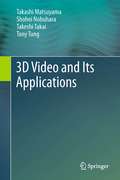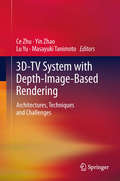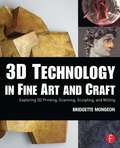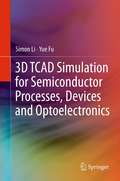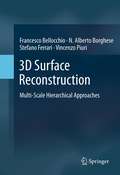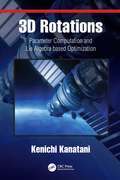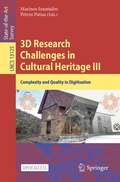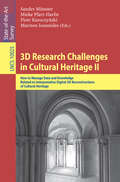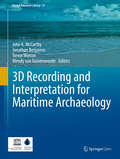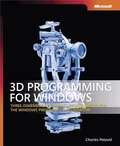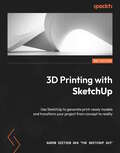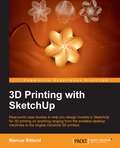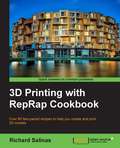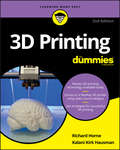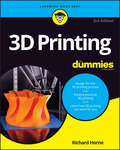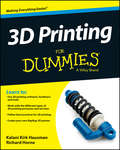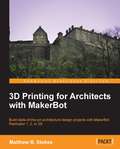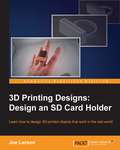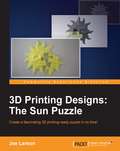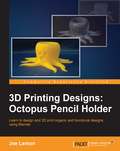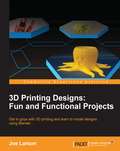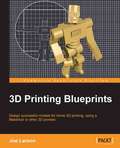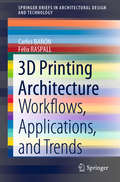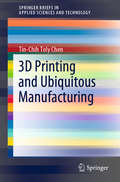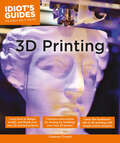- Table View
- List View
3D Video and Its Applications
by Shohei Nobuhara Tony Tung Takashi Matsuyama Takeshi TakaiThis book presents a broad review of state-of-the-art 3D video production technologies and applications. The text opens with a concise introduction to the field, before examining the design and calibration methods for multi-view camera systems, including practical implementation technologies. A range of algorithms are then described for producing 3D video from video data. A selection of 3D video applications are also demonstrated. Features: describes real-time synchronized multi-view video capture, and object tracking with a group of active cameras; discusses geometric and photometric camera calibration, and 3D video studio design with active cameras; examines 3D shape and motion reconstruction, texture mapping and image rendering, and lighting environment estimation; demonstrates attractive 3D visualization, visual contents analysis and editing, 3D body action analysis, and data compression; highlights the remaining challenges and the exciting avenues for future research in 3D video technology.
3D-TV System with Depth-Image-Based Rendering: Architectures, Techniques and Challenges
by Masayuki Tanimoto Ce Zhu Lu Yu Yin ZhaoRiding on the success of 3D cinema blockbusters and advances in stereoscopic display technology, 3D video applications have gathered momentum in recent years. 3D-TV System with Depth-Image-Based Rendering: Architectures, Techniques and Challenges surveys depth-image-based 3D-TV systems, which are expected to be put into applications in the near future. Depth-image-based rendering (DIBR) significantly enhances the 3D visual experience compared to stereoscopic systems currently in use. DIBR techniques make it possible to generate additional viewpoints using 3D warping techniques to adjust the perceived depth of stereoscopic videos and provide for auto-stereoscopic displays that do not require glasses for viewing the 3D image. The material includes a technical review and literature survey of components and complete systems, solutions for technical issues, and implementation of prototypes. The book is organized into four sections: System Overview, Content Generation, Data Compression and Transmission, and 3D Visualization and Quality Assessment. This book will benefit researchers, developers, engineers, and innovators, as well as advanced undergraduate and graduate students working in relevant areas.
3D Technology in Fine Art and Craft: Exploring 3D Printing, Scanning, Sculpting and Milling
by Bridgette MongeonThe possibilities for creation are endless with 3D printing, sculpting, scanning, and milling, and new opportunities are popping up faster than artists can keep up with them. 3D Technology in Fine Art and Craft takes the mystery out of these exciting new processes by demonstrating how to navigate their digital components and showing their real world applications. Artists will learn to incorporate these new technologies into their studio work and see their creations come to life in a physical form never before possible. Featuring a primer on 3D basics for beginners,interviews, tutorials, and artwork from over 80 artists, intellectual property rights information, and a comprehensive companion website, this book is your field guide to exploring the exhilarating new world of 3D. Follow step-by-step photos and tutorials outlining the techniques, methodologies, and finished products of master artists who have employed 3D technology in new and inventive ways Learn how to enlarge, reduce, and repurpose existing artwork and create virtual pieces in physical forms through a variety of mediums Research your options with an accessible list of pros and cons of the various software, 3D printers, scanners, milling machines, and vendors that provide services in 3D technology Listen to podcasts with the artists and learn more tips and tricks through the book's website at www.digitalsculpting.net
3D TCAD Simulation for Semiconductor Processes, Devices and Optoelectronics
by Suihua Li Simon LiTechnology computer-aided design, or TCAD, is critical to today's semiconductor technology and anybody working in this industry needs to know something about TCAD. This book is about how to use computer software to manufacture and test virtually semiconductor devices in 3D. It brings to life the topic of semiconductor device physics, with a hands-on, tutorial approach that de-emphasizes abstract physics and equations and emphasizes real practice and extensive illustrations. Coverage includes a comprehensive library of devices, representing the state of the art technology, such as SuperJunction LDMOS, GaN LED devices, etc.
3D Surface Reconstruction: Multi-Scale Hierarchical Approaches
by Vincenzo Piuri Francesco Bellocchio N. Alberto Borghese Stefano Ferrari3D Surface Reconstruction: Multi-Scale Hierarchical Approaches presents methods to model 3D objects in an incremental way so as to capture more finer details at each step. The configuration of the model parameters, the rationale and solutions are described and discussed in detail so the reader has a strong understanding of the methodology. Modeling starts from data captured by 3D digitizers and makes the process even more clear and engaging. Innovative approaches, based on two popular machine learning paradigms, namely Radial Basis Functions and the Support Vector Machines, are also introduced. These paradigms are innovatively extended to a multi-scale incremental structure, based on a hierarchical scheme. The resulting approaches allow readers to achieve high accuracy with limited computational complexity, and makes the approaches appropriate for online, real-time operation. Applications can be found in any domain in which regression is required. 3D Surface Reconstruction: Multi-Scale Hierarchical Approaches is designed as a secondary text book or reference for advanced-level students and researchers in computer science. This book also targets practitioners working in computer vision or machine learning related fields.
3D Rotations: Parameter Computation and Lie Algebra based Optimization
by Kenichi Kanatani3D rotation analysis is widely encountered in everyday problems thanks to the development of computers. Sensing 3D using cameras and sensors, analyzing and modeling 3D for computer vision and computer graphics, and controlling and simulating robot motion all require 3D rotation computation. This book focuses on the computational analysis of 3D rotation, rather than classical motion analysis. It regards noise as random variables and models their probability distributions. It also pursues statistically optimal computation for maximizing the expected accuracy, as is typical of nonlinear optimization. All concepts are illustrated using computer vision applications as examples. Mathematically, the set of all 3D rotations forms a group denoted by SO(3). Exploiting this group property, we obtain an optimal solution analytical or numerically, depending on the problem. Our numerical scheme, which we call the "Lie algebra method," is based on the Lie group structure of SO(3). This book also proposes computing projects for readers who want to code the theories presented in this book, describing necessary 3D simulation setting as well as providing real GPS 3D measurement data. To help readers not very familiar with abstract mathematics, a brief overview of quaternion algebra, matrix analysis, Lie groups, and Lie algebras is provided as Appendix at the end of the volume.
3D Research Challenges in Cultural Heritage III: Complexity and Quality in Digitisation (Lecture Notes in Computer Science #13125)
by Marinos Ioannides Petros PatiasThis open access book presents a collection of papers focusing on current 3D research challenges in the domain of digital cultural heritage. 3D technologies find considerable use within the field of cultural heritage at the beginning of the 21st century, for example in the areas of data acquisition, modeling, archiving in local repositories, harvesting in digital libraries and their long-term preservation. This volume put emphasis on a number of challenges facing 3D research in the 2D/3D digitization of tangible objects and their transformation to digital/virtual/memory twins; the interplay of geometry, semantics and the recovery and management of knowledge in digital cultural heritage; the handling of 3D data via the Cloud on the Internet and mobile devices; the presentation of cultural heritage content in 3D to the general public; and the 3D reproduction of cultural heritage objects from virtual to real.
3D Research Challenges in Cultural Heritage II: How to Manage Data and Knowledge Related to Interpretative Digital 3D Reconstructions of Cultural Heritage (Lecture Notes in Computer Science #10025)
by Sander Münster Mieke Pfarr-Harfst Piotr Kuroczyński Marinos IoannidesThis book reflects a current state of the art and future perspectives of Digital Heritage focusing on not interpretative reconstruction and including as well as bridging practical and theoretical perspectives, strategies and approaches. Comprehensive key challenges are related to knowledge transfer and management as well as data handling within a interpretative digital reconstruction of Cultural Heritage including aspects of digital object creation, sustainability, accessibility, documentation, presentation, preservation and more general scientific compatibility. The three parts of the book provide an overview of a scope of usage scenarios, a current state of infrastructures as digital libraries, information repositories for an interpretative reconstruction of Cultural Heritage; highlight strategies, practices and principles currently used to ensure compatibility, reusability and sustainability of data objects and related knowledge within a 3D reconstruction work process on a day to day work basis; and show innovative concepts for the exchange, publishing and management of 3D objects and for inherit knowledge about data, workflows and semantic structures.
3D Recording and Interpretation for Maritime Archaeology (Coastal Research Library #31)
by Wendy Van Duivenvoorde Trevor Winton Jonathan Benjamin John K. McCarthyThis open access peer-reviewed volume was inspired by the UNESCO UNITWIN Network for Underwater Archaeology International Workshop held at Flinders University, Adelaide, Australia in November 2016. Content is based on, but not limited to, the work presented at the workshop which was dedicated to 3D recording and interpretation for maritime archaeology. The volume consists of contributions from leading international experts as well as up-and-coming early career researchers from around the globe. The content of the book includes recording and analysis of maritime archaeology through emerging technologies, including both practical and theoretical contributions. Topics include photogrammetric recording, laser scanning, marine geophysical 3D survey techniques, virtual reality, 3D modelling and reconstruction, data integration and Geographic Information Systems. The principal incentive for this publication is the ongoing rapid shift in the methodologies of maritime archaeology within recent years and a marked increase in the use of 3D and digital approaches. This convergence of digital technologies such as underwater photography and photogrammetry, 3D sonar, 3D virtual reality, and 3D printing has highlighted a pressing need for these new methodologies to be considered together, both in terms of defining the state-of-the-art and for consideration of future directions. As a scholarly publication, the audience for the book includes students and researchers, as well as professionals working in various aspects of archaeology, heritage management, education, museums, and public policy. It will be of special interest to those working in the field of coastal cultural resource management and underwater archaeology but will also be of broader interest to anyone interested in archaeology and to those in other disciplines who are now engaging with 3D recording and visualization.
3D Programming for Windows®
by Charles PetzoldGet a focused introduction to programming 3D graphics with the Windows Presentation Foundation 3D API. Complementing his book Applications = Code + Markup, award-winning author Charles Petzold builds on XAML essentials, teaching you how to display and animate 3D graphics under the Microsoft .NET Framework 3.0 and Windows Vista. You'll get expert guidance and code samples in XAML and Microsoft Visual C#-- helping you master the skills you need to create high-fidelity user interfaces. Discover how to: Define complex 3D objects with triangle meshes Enhance the illumination of 3D surfaces with light and shading effects Color 3D figures with gradients, bitmaps, and drawings Add animation with transforms and vertex manipulation Represent linear, affine, and camera transforms by using matrices Calculate vector angles, angles of rotation, and axes of rotation Generate triangle meshes efficiently by using C# code Express rotation by using quaternion computation Provide a user interface for manipulating and drawing 3D figures PLUS--Get Visual C# and XAML code samples on the Web
3D Printing with SketchUp: Use SketchUp to generate print-ready models and transform your project from concept to reality, 2nd Edition
by Aaron Dietzen aka 'The SketchUp Guy'Create stunning 3D print-ready models quickly and easily using any version of SketchUpPurchase of the print or Kindle book includes a free PDF eBookKey FeaturesFind out how to use SketchUp Free, Go, or Pro to create print-ready modelsWork through clearly illustrated examples to learn just how to design for 3D printingModel multiple pieces that can be assembled post-printBook DescriptionWorking with the amazing 3D printing technology and getting access to the printing hardware is now easier than ever before. While there are many other resources that cover the general process of 3D printing, this book is the ultimate guide to creating models for 3D printing using SketchUp.You'll start with a basic understanding of how SketchUp is used in the 3D printing workflow and jump into the steps to create a print-ready model using only SketchUp. This 3D printing book will guide you in using SketchUp to modify existing 3D files and cover additional tools that make SketchUp an even more powerful modeling tool. As you advance, you'll learn how to transform 2D images into 3D printable solids, how to create multi-part prints that can be assembled without the use of fasteners or glue, and how to make sure your model, whether designed from scratch or assembled from preexisting geometry, is ready to be made real via your 3D printer.By the end of this book, you'll have the confidence to bring your design ideas to life by generating your own 3D print-ready models with SketchUp.What you will learnUnderstand SketchUp's role in the 3D printing workflowGenerate print-ready geometry using SketchUpImport existing files for editing in SketchUpVerify whether a model is ready to be printed or notModel from a reference object and use native editing toolsExplore the options available for adding onto SketchUp for the purpose of 3D printing (extensions)Understand the steps to export a file from SketchUpWho this book is forIf you own or have access to a 3D printer and are tired of downloading and printing other people's 3D models, this book is for you! Learn how to use SketchUp to create your own custom pieces or modify existing files so you can print exactly what you need. Whether you are an architect hoping to print buildings, a designer needing quick physical prototypes, or a hobbyist wanting to print a tchotchke, this book is for you. Readers should have completed some training in fundamentals in SketchUp and be able to create and edit basic geometry.
3D Printing with SketchUp
by Marcus RitlandThis book is a practical tutorial, packed with real-world case studies to help you design models that print right the first time. If you are familiar with SketchUp and want to print the models you've designed, then this book is ideal for you. You don't need any experience in 3D printing; however, SketchUp beginners will require a companion book or video training series to teach them the basic SketchUp skills.
3D Printing with RepRap Cookbook
by Richard SalinasA systematic guide consisting of over 100 recipes which focus on helping you understand the process of 3D printing using RepRap machines. The book aims at providing professionals with a series of working recipes to help make their fuzzy notions into real, saleable projects/objects using 3D printing technology. This book is for novice designers and artists who own a RepRap-based 3D printer, have fundamental knowledge of its working, and who desire to gain better mastery of the printing process. For the more experienced user, it will provide a handy visual resource, with side-by-side comparisons of the two most popular slicers, Skeinforge and Slic3r. A basic understanding of designing and modeling principles and elementary knowledge of digital modeling would be a plus.
3D Printing For Dummies
by Richard HorneThe bestselling book on 3D printing 3D printing is one of the coolest inventions we've seen in our lifetime, and now you can join the ranks of businesspeople, entrepreneurs, and hobbyists who use it to do everything from printing foods and candles to replacement parts for older technologies—and tons of mind-blowing stuff in between! With 3D Printing For Dummies at the helm, you'll find all the fast and easy-to-follow guidance you need to grasp the methods available to create 3D printable objects using software, 3D scanners, and even photographs through open source software applications like 123D Catch. Thanks to the growing availability of 3D printers, this remarkable technology is coming to the masses, and there's no time like the present to let your imagination run wild and actually create whatever you dream up—quickly and inexpensively. When it comes to 3D printing, the sky's the limit! Covers each type of 3D printing technology available today: stereolithology, selective sintering, used deposition, and granular binding Provides information on the potential for the transformation of production and manufacturing, reuse and recycling, intellectual property design controls, and the commoditization of products Walks you through the process of creating a RepRap printer using open source designs, software, and hardware Offers strategies for improved success in 3D printing On your marks, get set, innovate!
3D Printing For Dummies
by Richard HornePrint out whatever you can dream up 3D Printing For Dummies is an easy reference for anyone new to the process of taking a digital file and turning it into an object in the real world. (Pretty amazing stuff, right?) It’s also a handy guide for more experienced users looking to learn the latest and greatest in additive manufacturing. Updated for the latest generation of machines and materials, this book walks you through creating models and printing 3D objects. You’ll get the scoop on the impact of these versatile machines in production and manufacturing, reuse and recycling, intellectual property design controls, and more. It’s an exciting time to get into 3D printing, and this friendly Dummies guide is here to help you do it. Wrap your mind around the technology of 3D printing Understand how 3D printing is transforming industries Get an intro to making your own digital models Consider the pros and cons of 3D printing for your hobby or business needs3D Printing For Dummies is a perfect resource for anyone interested in learning about and taking advantage of 3D printing technology.
3D Printing For Dummies
by Richard Horne Kalani Kirk HausmanGet started printing out 3D objects quickly and inexpensively!3D printing is no longer just a figment of your imagination. This remarkable technology is coming to the masses with the growing availability of 3D printers. 3D printers create 3-dimensional layered models and they allow users to create prototypes that use multiple materials and colors. This friendly-but-straightforward guide examines each type of 3D printing technology available today and gives artists, entrepreneurs, engineers, and hobbyists insight into the amazing things 3D printing has to offer. You'll discover methods for the creation of 3D printable objects using software, 3D scanners, and even photographs with the help of this timely For Dummies guide.Includes information on stereolithography, selective sintering, fused deposition, and granular binding techniquesCovers the potential for the transformation of production and manufacturing, reuse and recycling, intellectual property design controls, and the commoditization of traditional products from magazines to material goodsWalks you through the process of creating a RepRap printer using open-source designs, software, and hardwareAddresses the limitations of current 3D printing technologies and provides strategies for improved success3D Printing For Dummies is the must-have guide to make manufacturing your own dynamic designs a dream come true!
3D Printing for Architects with MakerBot
by Matthew B. StokesThis is a hands-on tutorial for a user to become well-versed with 3D printing using MakerBots."3D Printing for Architects with MakerBot" is ideal for architects looking to creating stunning prototypes using the MakerBot Replicator 2X 3D printer. Having experience using 3D CAD software is beneficial but not necessary as this book mentions several different CAD packages for beginners, up to those more advanced users who are perhaps looking for additional features.
3D Printing Designs: Design an SD Card Holder
by Joe LarsonLearn how to design 3D-printed objects that work in the real world About This Book * This book shows you how to design from a reference to physical objects that can be easily represented by simple basic objects in Blender (cube, cylinder, sphere, and so on) by measuring them * This is the only book on the market that shows you how to take your first steps to create 3D printed objects that are able to interact with existing objects * Learn how to utilize Blender's functionality to make your designs more precise and accurate Who This Book Is For Reader will have basic knowledge of Blender and 3D Printing, and will have probably already made something simple. They will be interested in printing their first object. What You Will Learn * Gain techniques to accurately measure the objects with rules, manual calipers, and digital calipers * Break down complex geometries into multiple simple shapes and model them in layers using Blender * Scale and re-scale a model to fit based on volume or size constraints * See how to multishell geometries and auto-intersections using the Boolean Modifier In Detail Want to model a 3D printed prototype of an object that needs to be replaced or broken? This book will teach you how to accurately measure objects in the real world with a few basic measuring techniques and how to create an object for 3D printing around the objects measured. In this book, you'll learn to identify basic shapes from a given object, use Vernier and Digital calipers and grid paper tracing techniques to derive measurements for the objects. With the help of measurements, you'll see to model these objects using Blender, organize the parts into layers, and later combine them to create the desired object, which in this book is a 3D printable SD card holder ring that fits your finger. Style and approach This book will be an easy-to-follow guide to learn the methods of scaling, precise measurements, and accurate designing. Using a step-by-step approach, this book will guide you on your journey to model different parts of a complex object and later combine them to create 3D printed objects that work in the real world.
3D Printing Designs: The Sun Puzzle
by Joe LarsonCreate a fascinating 3D printing-ready puzzle in no time! About This Book * Learn how to design a 3D printable model from an existing physical object * Rekindle your mathematical mind to design perfectly interlocking complex pieces of a puzzle * Personalize the puzzle's design with a photo or shape of your own choice Who This Book Is For The book is meant for fairly advanced 3D printing designers who know their way around Blender, and know how to print out basic shapes. What You Will Learn * Design, manipulate, and export 3D models for 3D printing with Blender * Master the art from creating meshes, scaling, subdivision, and adding detail with the Boolean modifier to sculpting a custom shape * Cut a model into small pieces and learn to design complex interlocking joints In Detail Jigsaw puzzles derive their name from when they were cut from wood sheets using a hand-woodworking tool called a jig saw back in the 1760s. Have you ever wondered how a model idea for a jigsaw puzzle is articulated, and how it was made with these traditional tools? Through this book, you will master the techniques of designing simple to complex puzzles models for 3D printing. We will quickly introduce you to some simple and effective principles of designing 3D printed objects using Blender. Through the course of the book, you'll explore various robust sculpting methods supported by Blender that allow you to edit objects with actions such as bends or curves, similar to drawing or building up a clay structure of different shapes and sizes. Finally, when the model is sculpted, you'll learn some methods to cut the model and carve out multiple pieces of perfectly-fitting edges of different geometries to complete the puzzle. Style and approach This practical guide explores the union of 3D printing techniques and working with Blender to create intuitive puzzle designs. With a step-by-step approach, you'll learn to use Blender's shape editing tools to make a basic puzzle shape and combine that with the sculpted model to create the final piece for 3D printing.
3D Printing Designs: Octopus Pencil Holder
by Joe LarsonLearn to design and 3D print organic and functional designs using Blender About This Book * Learn how to make complex shapes by editing basic ones * Make printable objects from multiple shapes and parts * Learn how to design from scratch, without a reference to physical objects Who This Book Is For You should have basic knowledge of Blender and 3D printing and be interested in printing your first object. What You Will Learn * Get to know the guiding principles required to create 3D printer-friendly models * Understand material characteristics, printing specifications, tolerances, and design tips * Master the art of modifying basic shapes with Blender's powerful editing tools: extrude, loop cuts, and other transformations * Learn techniques of editing complex meshes, smoothing, combining shapes, and exporting them into STL files for printing In Detail This book will cover the very basic but essential techniques you need to model an organic and functional object for 3D printing using Blender. Starting with pen and paper and then moving on to the computer, you will create your first project in Blender, add basic geometric shapes, and use techniques such as extruding and subdividing to transform these shapes into complex meshes. You will learn how modifiers can automatically refine the shape further and combine multiple shapes into a single 3D printable model. By the end of the book, you will have gained enough practical hands-on experience to be able to create a 3D printable object of your choice, which in this case is a 3D print-ready octopus pencil holder. Style and approach This is a starter project designed to introduce you to your first real-world 3D printing designs, where you'll learn how to handle the fundamental principles of 3D printing design and have your hands on your reward in no time.
3D Printing Designs: Fun and Functional Projects
by Joe LarsonGet to grips with 3D printing and learn to model designs using Blender About This Book * From the author who brought you the first practical look at 3D printing with 3D Printing Blueprints * Get a comprehensive coverage of the prototyping techniques you need to know to start printing your own 3D designs * Rekindle your mathematical genius to design personalized objects for complex puzzles Who This Book Is For If you're new to the world of 3D printing, this is the book for you. Some basic knowledge of Blender and geometry would be helpful, but is not necessary. What You Will Learn * Get to know about the different types of 3D printers and their limitations * See how Y, H, and T shapes illustrate different ideas of successful 3D design for home 3D printers * Set up and configure Blender to model a file for 3D printing * Understand material characteristics, printing specifications, tolerances, and design tips * Work through the techniques of editing complex meshes, smoothing, combining shapes, and exporting them into STL files for printing * Break down complex geometries into multiple simple shapes and model them in layers using Blender * Design, manipulate, and export 3D models for 3D printing with Blender * Master the art of creating meshes, scaling, subdivision, and adding detail with the Boolean modifier as well as sculpting a custom shape * Cut a model into small pieces and understand how to design complex interlocking joints that form a part of a jigsaw puzzle In Detail 3D printing has revolutionized the way that global industries conceptualize and design products for mass consumption. Considered as the next "trillion-dollar" business, every industry is in the race to equip its personnel with techniques to prototype and simplify complex manufacturing process. This book will take you through some simple to complex and effective principles of designing 3D printed objects using Blender. There is a comprehensive coverage of projects such as a 3D print-ready octopus pencil holder, which will teach you how to add basic geometric shapes, and use techniques such as extruding and subdividing to transform these shapes into complex meshes. Furthermore, you'll learn to use various techniques to derive measurements for an object, model these objects using Blender, organize the parts into layers, and later combine them to create the desired object with the help of a 3D printable SD card holder ring design project. The final project will help you master the techniques of designing simple to complex puzzles models for 3D printing. Through the course of the book, we'll explore various robust sculpting methods supported by Blender to create objects. You'll move, rotate, and scale the object, and manipulate the view. You'll edit objects with actions such as bends or curves, similar to drawing or building up a clay structure of different shapes and sizes. By the end of the book, you will have gained thorough practical hands-on experience to be able to create a real-world 3D printable object of your choice. Style and approach This is a hands-on guide to the world of 3D printing. With the help of simple to complex projects, you'll learn various techniques to design 3D printable objects using Blender.
3D Printing Blueprints
by Joe Larson"3D Printing Blueprints" is not about how to just make a ball or a cup. It includes fun-to-make and engaging projects. Readers don't need to be 3D printing experts, as there are examples related to stuff people would enjoy making. "3D Printing Blueprints" is for anyone with an interest in the 3D printing revolution and the slightest bit of computer skills. Whether you own a 3D printer or not you can design for them. All it takes is Blender, a free 3D modeling tool. Couple this book with a little creativity and someday you'll be able to hold something you designed on the computer in your hands.
3D Printing Architecture: Workflows, Applications, and Trends (SpringerBriefs in Architectural Design and Technology)
by Carlos BAÑÓN Félix RASPALLThis book investigates how architectural design advances as a result of the rapid developments in 3D Printing. As this technology become more powerful, faster and cheaper, novel workflows are becoming available and revolutionizing all stages of the design process, from early spatial concepts, to subsequent project development, advanced manufacturing processes, and integration into functional buildings. Based on a literature review and case studies of ten built projects, the book discusses the implications of the ongoing manufacturing revolution for the field of architecture.
3D Printing and Ubiquitous Manufacturing (SpringerBriefs in Applied Sciences and Technology)
by Tin-Chih Toly ChenThis book provides a thorough overview of the applications of 3D printing technologies to ubiquitous manufacturing (UM). UM itself represents an application of ubiquitous computing in the manufacturing sector, and this book reveals how it offers convenient, on-demand network access to a shared pool of configurable manufacturing resources, including software tools, equipment, and capabilities. Given its scope, the book will be of considerable interest to researchers in the areas of manufacturing, mechanical engineering, operations management, production control, ubiquitous computing, and sensor technologies, as well as practicing managers and engineers.
3D Printing (Idiot's Guides)
by Cameron Coward3D printing is the hottest new technology. It allows just about any at-home inventor, artist, or engineer to design, create, and "print" their own parts, artwork, or whatever else can be imagined — all at very reasonable costs. Idiot's Guides: 3D Printing explores this new revolution by explaining all of the basics of materials, parts, software, modeling, design, and finishing. The book then takes it to the next level by teaching readers how to take their new skills and print some simple, fun projects. Helpful advice on setting up a home-built 3D printer, buying a manufactured printer, selecting raw materials, and finding plans and projects online, are also covered.
